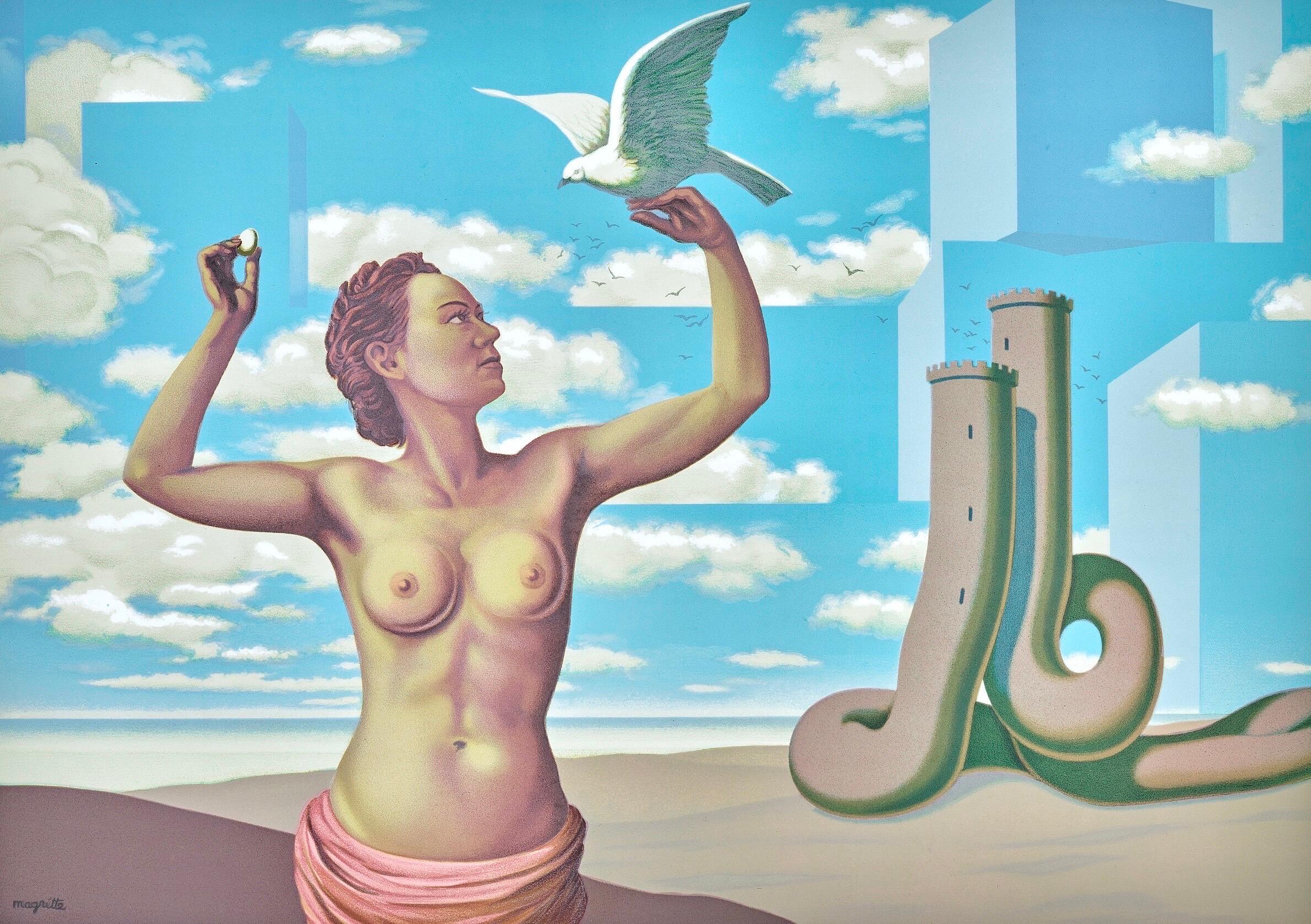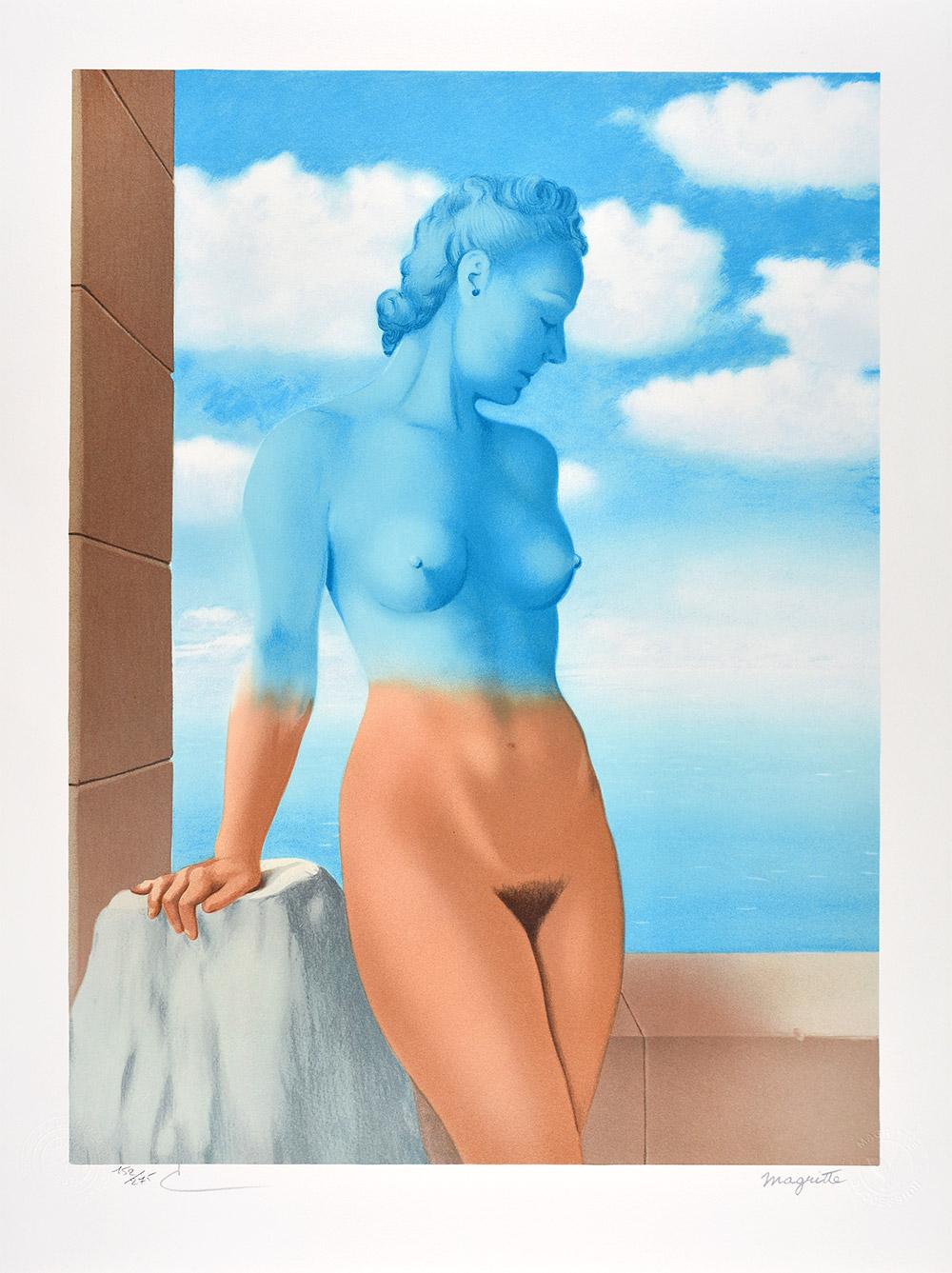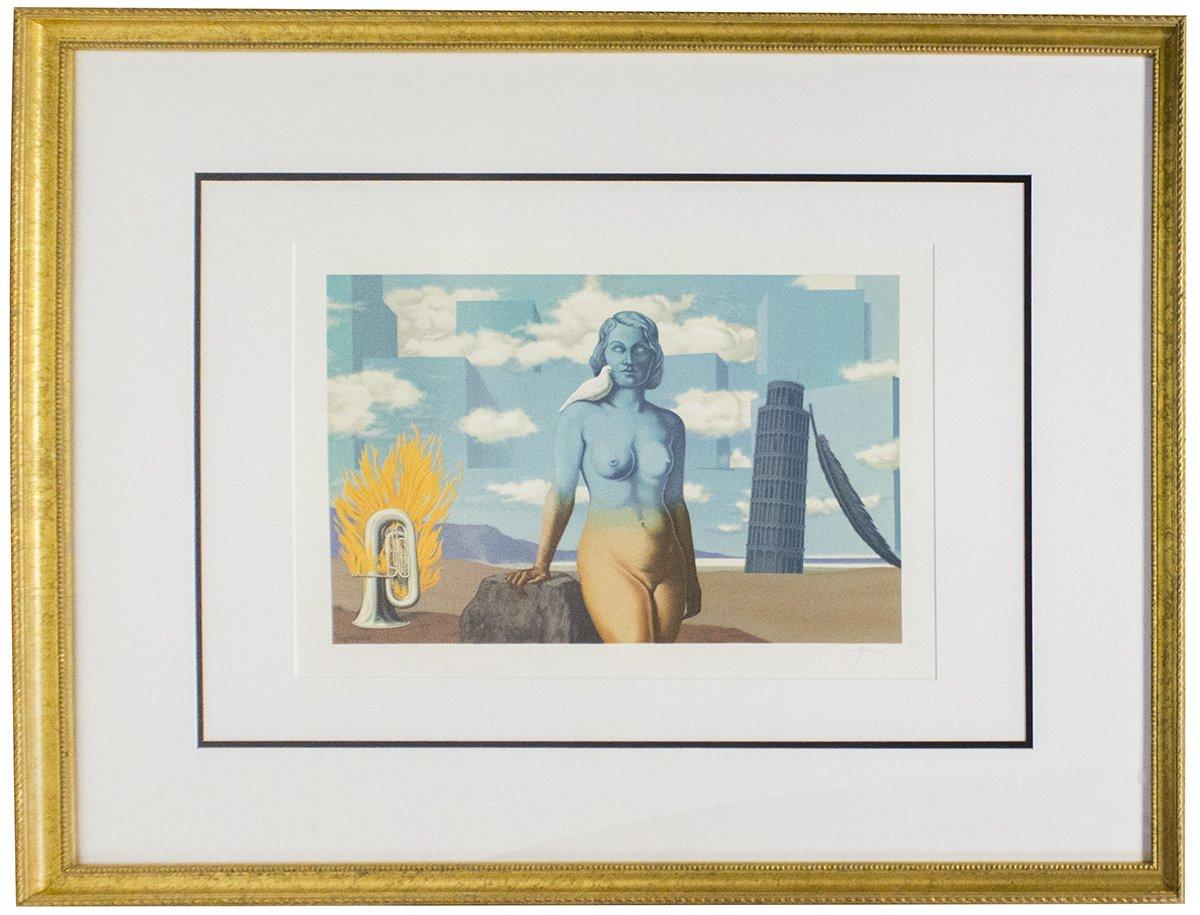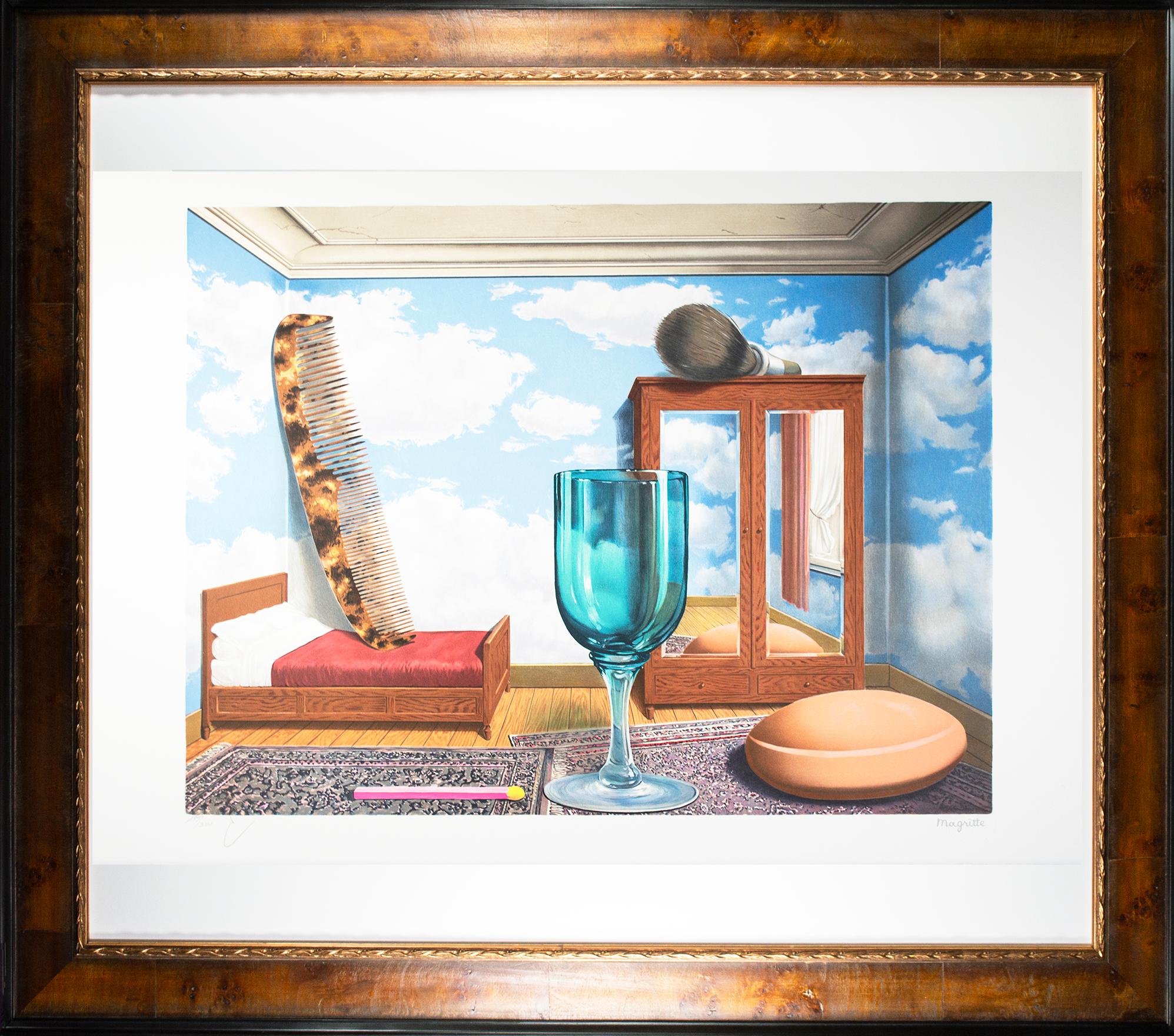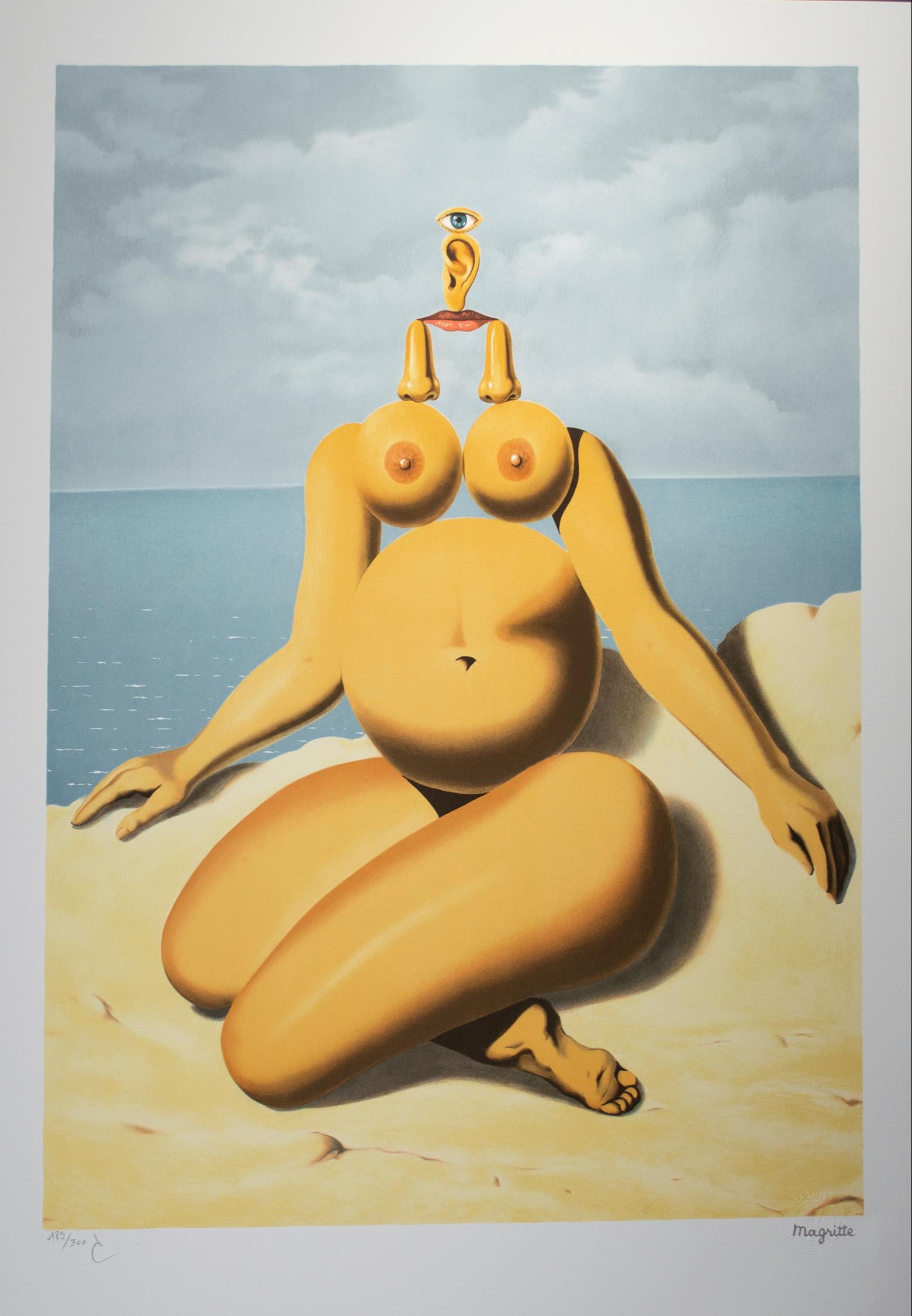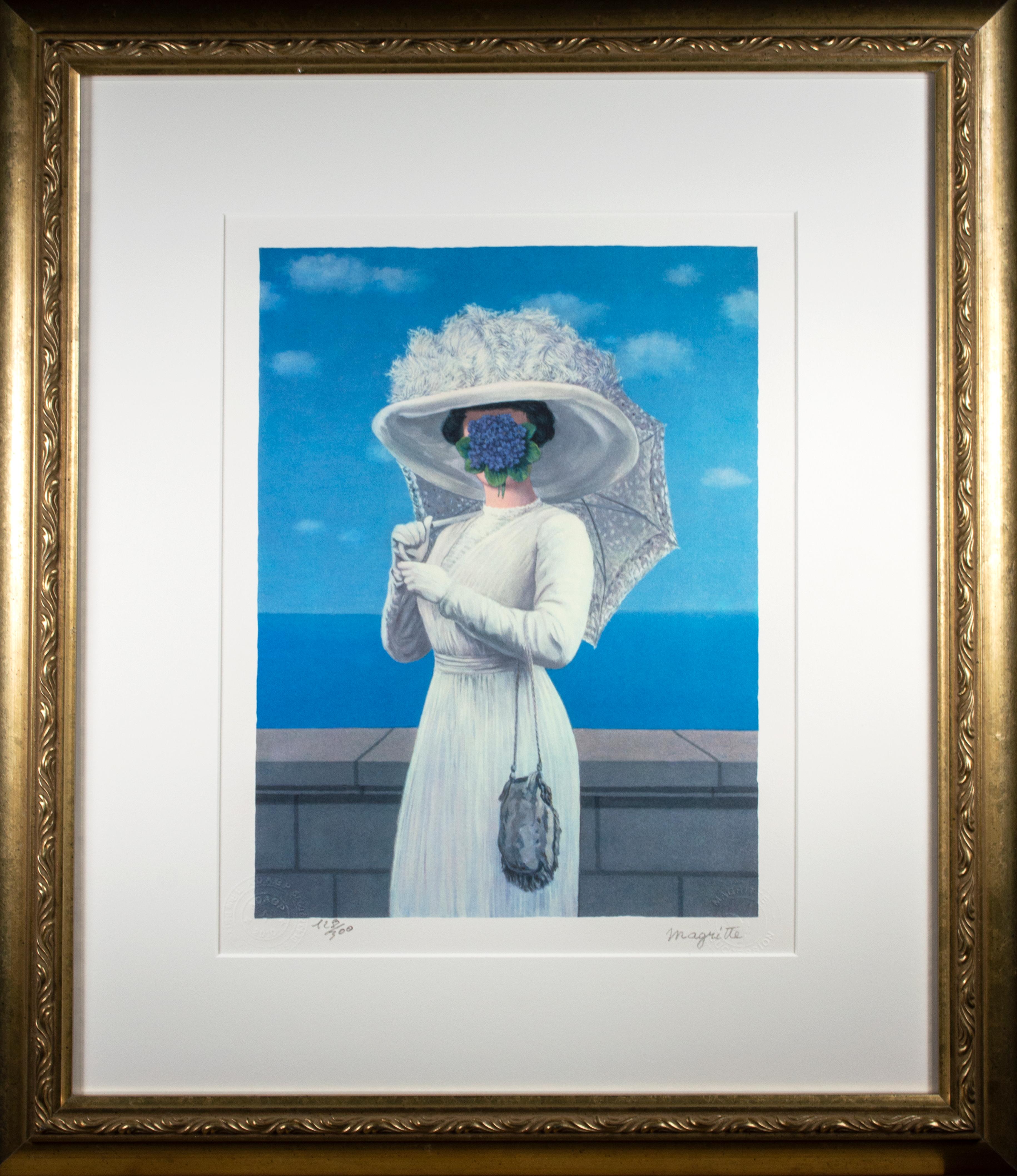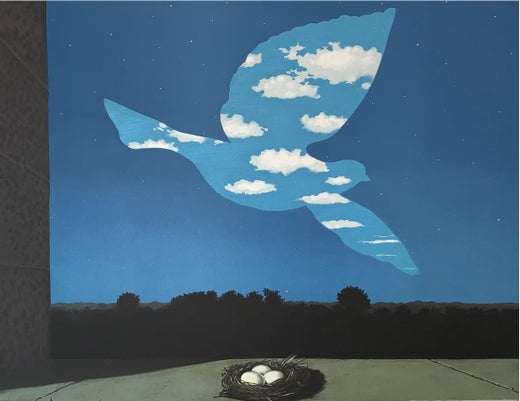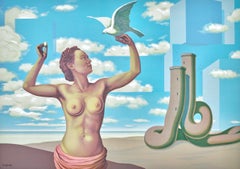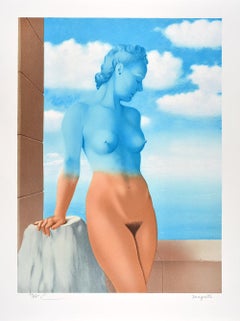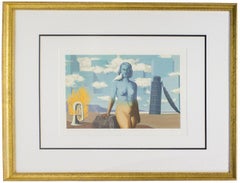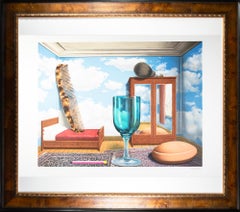Items Similar to Une Jeune Femme Presente Avec Grace, from Les Enfants Trouves
Want more images or videos?
Request additional images or videos from the seller
1 of 11
(after) René MagritteUne Jeune Femme Presente Avec Grace, from Les Enfants Trouves1953, published 1968
1953, published 1968
$2,125
£1,629.08
€1,864.13
CA$3,003.10
A$3,264.26
CHF 1,747.41
MX$39,457.28
NOK 22,020.75
SEK 20,308.85
DKK 13,922.06
About the Item
This artwork titled "" Une Jeune Femme Presente Avec Grace" from the suite" Les Enfants Trouves created in 1953 and printed/published in 1968 in an edition of 350. This artwork come from the edition numbered 239/350 on the colophon of the suite. It is a color lithograph on paper by renown Belgian artist, Rene Magritte 1898-1967. It is signed in the stone by the artist and signed in pencil at the lower right corner by the printer, Fernand Mourlot. Published by A.C Mazo, Paris, France and printed by Fernand Mourlot, Paris, France. The image size is 12.5 x 17.75 inches, sheet size is 17.5 23.5 inches, framed size is 24.5 x 28.75 inches. Framed in a custom wooden gold frame, with fabric matting and gold color spacer. It is in excellent condition.
About the artist.
Rene Magritte was born on the 21st November, 1898 in Hainaut, Belgium. His father was a tailor and a merchant. As his business did not go well the family had to move often. René lost his mother early and tragically - she committed suicide for unclear reasons. René was only 14 years old at the time.
From 1916 through 1918 Magritte studied in the Royal Academy of Arts in Brussels (Académie Royale des Beaux-Arts). He became a wallpaper designer and commercial artist. His early painting works were executed under the influence of the Cubism and Futurism (1918-20), then he was inspired by the Purists and Fernand Léger. In 1922 Magritte married Georgette Berger, with whom he first became acquainted when fifteen years old. After meeting again in 1920, she became his model and then wife.
The friendship with Giorgio de Chirico's and Dadaistic poetry constituted an important artistic turning-point for Magritte. In 1925 he came close with a group of Dadaists and co-operated in the magazines Aesophage and Marie, together with E.L.T. Mesens, Jean Arp, Francis Picabia, Schwitters, Tzara and Man Ray.
In 1926 Magritte painted The Lost Jockey, it is his first painting that he allowed to be labeled as "Surrealist". After his first, badly-received, one-man show in Brussels in 1927, he left for Paris. In 1927-30 Magritte lived in France, where he participated in the activities of the Surrealists, establishing a close friendship in particular with Max Ernst, Dali, André Breton and especially with Paul Eluard.
In Paris, Magritte's system of conceptual painting was formed, it remained almost unchanged until the end of his life.
Demonstrating the problems of visual perception and illusionary of images, Magritte used the symbols of mirrors, eyes, windows, stages and curtains and pictures within pictures (The False Mirror, 1935, The Key to the Fields. 1936, Beautiful World. 1962.)
In the 1950s Magritte executed two fresco cycles: The Enchanted Realm for a casino in Knokke-le-Zut (1953) and The Ignorant Fairy (1957) for the Palais des Beaux-Arts in Charleroi. These monumental compositions repeat the motifs of his previous paintings. In his last year Magritte began to make sculptures of his painted images. Rene Magritte’s work is held in numerous major museums and collections worldwide. Magritte died of pancreatic cancer on 15 August 1967, and was interred in Schaerbeek Cemetery, Evere, Brussels.
- Creator:(after) René Magritte (1898 - 1967, Belgian)
- Creation Year:1953, published 1968
- Dimensions:Height: 24.5 in (62.23 cm)Width: 28.75 in (73.03 cm)Depth: 1.35 in (3.43 cm)
- Medium:
- Movement & Style:
- Period:
- Condition:
- Gallery Location:San Francisco, CA
- Reference Number:Seller: magritte/ 10041stDibs: LU66633494571
(after) René Magritte
Rene Magritte was born in Lessines, in 1898. Magritte's earliest oil paintings, which date from about 1915, were Impressionistic in style. From 1916 to 1918 he studied at the Academie Royale des Beaux-Arts in Brussels, under Constant Montald, but found the instruction uninspiring. The oil paintings he produced during the years 1918-1924 were influenced by Futurism and by the offshoot of Cubism practiced by Metzinger. Most of his works of this period are female nudes. In 1922 Magritte married Georgette Berger, whom he had met as a child in 1913. From December 1920 until September 1921, Magritte served in the Belgian infantry in the Flemish town of Beverlo near Leopoldsburg. In 1922-1923, he worked as a draughtsman in a wallpaper factory, and was a poster and advertisement designer until 1926, when a contract with Galerie la Centaure in Brussels made it possible for him to paint full-time. In 1926, Magritte produced his first surreal oil painting, The Lost Jockey (Le jockey perdu), and held his first exhibition in Brussels in 1927. Critics heaped abuse on the exhibition. Depressed by the failure, he moved to Paris where he became friends with Andre Breton, and became involved in the surrealist group. During the German occupation of Belgium in World War II he remained in Brussels, which led to a break with Breton. He briefly adopted a colorful, painterly style in 1943-44, an interlude known as his "Renoir Period", as a reaction to his feelings of alienation and abandonment that came with living in German occupied Belgium. In 1946, renouncing the violence and pessimism of his earlier work, he joined several other Belgian artists in signing the manifesto Surrealism in Full Sunlight. During 1947-48-Magritte's "Vache Period"-he painted in a provocative and crude Fauve style. During this time, Magritte supported himself through the production of fake painting of Picasso, van Gogh, Manet and Paul Cezanne - a fraudulent repertoire he was later to expand into the printing of forged banknotes during the lean postwar period. This venture was undertaken alongside his brother Paul Magritte and fellow Surrealist and 'surrogate son' Marcel Marien, to whom had fallen the task of selling the forgeries. At the end of 1948, he returned to the style and themes of his prewar surrealistic art. Magritte wished to cultivate an approach that avoided the stylistic distractions of most modern painting. While French Surrealists experimented with new techniques, Magritte settled on a deadpan, illustrative technique that clearly articulated the content of his pictures. Repetition was an important strategy for Magritte, informing not only his handling of motifs within individual pictures, but also encouraging him to produce multiple copies of some of his greatest works. His interest in the idea may have come in part from Freudian psychoanalysis, for which repetition is a sign of trauma. But his work in commercial art may have also played a role in prompting him to question the conventional modernist belief in the unique, original work of art.
About the Seller
5.0
Platinum Seller
Premium sellers with a 4.7+ rating and 24-hour response times
Established in 1999
1stDibs seller since 2017
869 sales on 1stDibs
Typical response time: <1 hour
- ShippingRetrieving quote...Shipping from: San Francisco, CA
- Return Policy
More From This Seller
View AllSurrealist Scene with Lady
Located in San Francisco, CA
This artwork, Surrealist Scene with Lady c.1980 is an original color lithograph by Italian/Israeli artist Mario Doretti, born 1929. It is Hand signed and numbered 43/200 in pencil by...
Category
Late 20th Century Surrealist Figurative Prints
Materials
Lithograph
"La Deese de Cythere" from the suite "l'Art d'Aimer d'Ovide"
By Salvador Dalí
Located in San Francisco, CA
This artwork titled, "La Deesse de Cythere" from the suite, "l'Art d'Aimer d'Ovide" 1976. is an original wood engraving on Japan nacre paper by artist Salvador Dali 1904-1989. It i...
Category
Late 20th Century Surrealist More Prints
Materials
Woodcut
"Mais O Belle Dionee" from the suite "lArt d'Aimer d'Ovide"
By Salvador Dalí
Located in San Francisco, CA
This artwork titled, "Mais O Belle Dionee" from the suite, "l'Art d'Aimer d'Ovide" 1976. is an original wood engraving on Japan nacre paper by artist Salvador Dali 1904-1989. It is...
Category
Late 20th Century Surrealist Nude Prints
Materials
Woodcut
Surrealist Scene
Located in San Francisco, CA
This artwork, Surrealist Scene c.1980 is an original color lithograph by Italian/Israeli artist Mario Doretti, born 1929. It is Hand signed and numbered 43/200 in pencil by the artis...
Category
Late 20th Century Surrealist Figurative Prints
Materials
Lithograph
l' Hirondelle
By Salvador Dalí
Located in San Francisco, CA
Artist: Salvador Dali (Spanish surrealist, 1904-1989)
Title: L'Hirondelle
Year: 1973
Medium: Color lithograph
Edition: Numbered XLVI/CCL in pencil
Paper: Arches watermarked
Image size: 18.5 x 25 inches
paper size: 19 x 25.5 inches
Signature: Hand signed in pencil by the artist
Publisher: Martin Lawrence and Jacques Carpentier...
Category
1970s Surrealist Figurative Prints
Materials
Lithograph
Le Cracking du Petrole
By Salvador Dalí
Located in San Francisco, CA
Artist: Salvador Dali (Spanish surrealist, 1904-1989)
Title: Le Cracking Du Petrole
Year: 1975
Medium: Engraving with etching and stencil hand coloring
Edition: Numbered 171/450 in p...
Category
1970s Surrealist Figurative Prints
Materials
Engraving
You May Also Like
Rene Magritte, A Young Woman Presents with Grace, 1968 (after)
By René Magritte
Located in Southampton, NY
This exquisite lithograph after Rene Magritte (1898–1967), titled Une Jeune Femme Presente avec Grace (A Young Woman Presents with Grace), from the folio Les Enfants Trouves de Magritte (The Found Children of Magritte), 1968, originates from the edition published by A.C. Mazo et Cie, Paris, and printed by Mourlot Freres, Paris, on November 20, 1968. The work embodies Magrittes sustained inquiry into semiotics and visual epistemology, translating his characteristic strategies of displacement, symbolic inversion, and conceptual ambiguity into an image that operates as both a poetic metaphor and a philosophical proposition concerning the instability of meaning.
Executed as a lithograph on grand velin dArches paper, this work measures 17.5 x 23.5 inches (44.5 x 59.7 cm). Signed in the plate by the artist; hand signed by Fernand Mourlot, Editeur. The edition exemplifies the technical mastery of the Mourlot atelier.
Artwork Details:
Artist: After Rene Magritte (1898–1967)
Title: Une Jeune Femme Presente avec Grace (A Young Woman Presents with Grace), from the folio Les Enfants Trouves de Magritte (The Found Children of Magritte)
Medium: Lithograph on grand velin dArches paper
Dimensions: 17.5 x 23.5 inches (44.5 x 59.7 cm)
Inscription: Signed in the plate by the artist; hand signed by Fernand Mourlot, Editeur
Date: 1968
Publisher: A.C. Mazo et Cie, Paris
Printer: Mourlot Freres, Paris
Catalogue Raisonne: Magritte, Rene, et al. Rene Magritte: Catalogue Raisonne, Vol. 3. Menil Foundation; Philip Wilson Publishers; Distributed in the USA and Canada by Rizzoli International, 1992, nos. 791–792 and 1056; vol. 5, p. 218, Bibliography entry 68.28.
Condition: Well preserved, consistent with age and medium
Provenance: From the folio Les Enfants Trouves de Magritte, 1968
Notes:
Excerpted from the folio (translated from French), Finished printing in Paris on November 20, 1968, on the presses of Mourlot, for the lithographs. The unpublished text by Louis Scutenaire was composed in Elzevir Casion corps 28 and printed by Fequet et Baudier, typographers. The unpublished compositions numbered from I to IV were specially made by Rene Magritte for this album. The compositions of the Enchanted Domain, are the renderings of the eight paintings of the mural of the Casino de Knokke. They were printed with the benevolent authorization of Mr. Gustave J. Nellens. Justification of the draw, this album was taken from CCCL examples on grand velin dArches numbered from I to CCCL, plus a few examples for collaborators and assistants.
About the Publication:
Les Enfants Trouves de Magritte (The Found Children of Magritte), published in 1968 by A.C. Mazo et Cie, Paris, represents one of the most significant late life print projects devoted to Rene Magrittes work. Conceived as both a literary and visual tribute, the folio pairs texts by the Belgian writer Louis Scutenaire, Magrittes close friend and fellow Surrealist, with lithographic interpretations produced at the Mourlot atelier, the premier lithographic workshop of twentieth century France. The album includes compositions by Magritte alongside lithographic renderings of the celebrated Enchanted Domain mural from the Casino de Knokke, printed with the authorization of Gustave J. Nellens, who commissioned the original mural. Issued in a single edition of CCCL examples on grand velin dArches, the folio stands as a testament to the collaboration between artist, writer, publisher, and master printer, and remains one of the most culturally important Surrealist print albums of the post war era.
About the Artist:
Rene Magritte (1898–1967) was a Belgian Surrealist painter whose visionary, intellectual, and poetic imagery redefined twentieth century art and forever changed how the world perceives reality and illusion. Celebrated for his calm precision and thought provoking juxtapositions of ordinary objects in extraordinary contexts, Magritte used painting as a philosophical tool, transforming the everyday into visual paradoxes that challenged the boundaries between what is seen and what is known. Born in Lessines, Belgium, and trained at the Academie Royale des Beaux Arts in Brussels, he absorbed early influences from Cubism, Futurism, and Symbolism before embracing Surrealism, where he found his true voice. In Paris, he became part of the avant garde circle that included Pablo Picasso, Alexander Calder, Alberto Giacometti, Salvador Dali, Joan Miro, Wassily Kandinsky, Marcel Duchamp, and Man Ray—all artists whose radical ideas helped him forge his distinctive synthesis of logic and mystery. Unlike Dalis dream...
Category
1960s Surrealist Landscape Prints
Materials
Lithograph
$3,996 Sale Price
20% Off
Free Shipping
RENÉ MAGRITTE: LA MAGIE NOIRE, 1945 - Limited edition Lithograph Surrealism
By (after) René Magritte
Located in Madrid, Madrid
LA MAGIE NOIRE, 1945 (BLACK MAGIC)
Date of creation: 2010
Medium: Lithograph on BFK Rives Paper
Edition: 275
Size: 60 x 45 cm
Observations: Lithograph on BFK Rives paper plate signed...
Category
Mid-20th Century Surrealist Figurative Prints
Materials
Lithograph
Magritte 1968 'Le Domaine Enchante (VI)' FRAMED Hand signed Mourlot
By René Magritte
Located in Brooklyn, NY
This limited edition lithograph, signed by Fernand Mourlot beneath the right-hand corner of the image, is part of a suite of eight “Le Domaine Enchanté” images, printed in an edition...
Category
1960s Surrealist Prints and Multiples
Materials
Lithograph
$975 Sale Price
35% Off
"Les valeurs personnelles (Personal Values), " Lithograph after Rene Magritte
By René Magritte
Located in Milwaukee, WI
"Les valeurs personnelles (Personal Values)" is a color lithograph after the original 1952 painting by Rene Magritte. This interior scene has objects of various sizes. A comb, match, brush, and glass are bigger than typically larger objects like a queen bed and chest of drawers. The walls are a bright cloudy sky.
Art: 19.63 x 4.75 in
Frame: 34.13 x 38.88 in
René-François-Ghislain Magritte was born November 21, 1898, in Lessines, Belgium and died on August 15, 1967 in Brussels. He is one of the most important surrealist artists. Through his art, Magritte creates humor and mystery with juxtapositions and shocking irregularities. Some of his hallmark motifs include the bourgeois “little man,” bowler hats, apples, hidden faces, and contradictory texts.
René Magritte’s father was a tailor and his mother was a miller. Tragedy struck Magritte’s life when his mother committed suicide when he was only fourteen. Magritte and his two brothers were thereafter raised by their grandmother.
Magritte studied at the Brussels Academy of Fine Arts from 1916 to 1918. After graduating he worked as a wallpaper designer and in advertisement. It was during this period that he married Georgette Berger, whom he had known since they were teenagers.
In 1926, René Magritte signed...
Category
Early 2000s Surrealist Interior Prints
Materials
Lithograph
"La race blanche (The White Race), " Lithograph after Painting by Rene Magritte
By René Magritte
Located in Milwaukee, WI
"La race blanche (The White Race)" is a color lithograph after the original 1937 painting by Rene Magritte. A female figure is made out of a mix of body parts. An eye sits on top of an ear, which is on top of a mouth, then two noses. Two breasts lying on a stomach; two arms come from the breasts. Legs are tucked under the stomach. This figure is on a sand dune next to the ocean.
Art: 26.5 x 19.63 in
Frame: 40.88 x 33.88 in
René-François-Ghislain Magritte was born November 21, 1898, in Lessines, Belgium and died on August 15, 1967 in Brussels. He is one of the most important surrealist artists. Through his art, Magritte creates humor and mystery with juxtapositions and shocking irregularities. Some of his hallmark motifs include the bourgeois “little man,” bowler hats, apples, hidden faces, and contradictory texts.
René Magritte’s father was a tailor and his mother was a miller. Tragedy struck Magritte’s life when his mother committed suicide when he was only fourteen. Magritte and his two brothers were thereafter raised by their grandmother.
Magritte studied at the Brussels Academy of Fine Arts from 1916 to 1918. After graduating he worked as a wallpaper designer and in advertisement. It was during this period that he married Georgette Berger, whom he had known since they were teenagers.
In 1926, René Magritte signed...
Category
Early 2000s Surrealist Figurative Prints
Materials
Lithograph
"La Grande Guerre (The Great War), " Color Lithograph after Rene Magritte
By René Magritte
Located in Milwaukee, WI
"La Grande Guerre (The Great War)" is a color lithograph after the 1964 painting by Rene Magritte. A Victorian lady stands in white facing the viewer. A bouq...
Category
2010s Surrealist Figurative Prints
Materials
Lithograph
